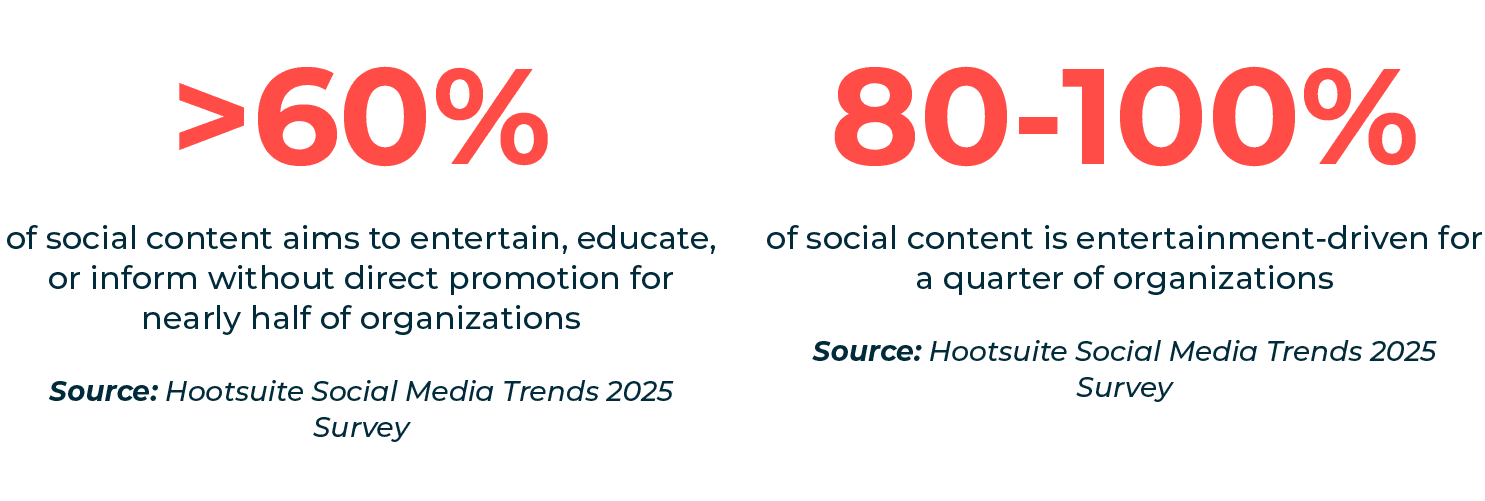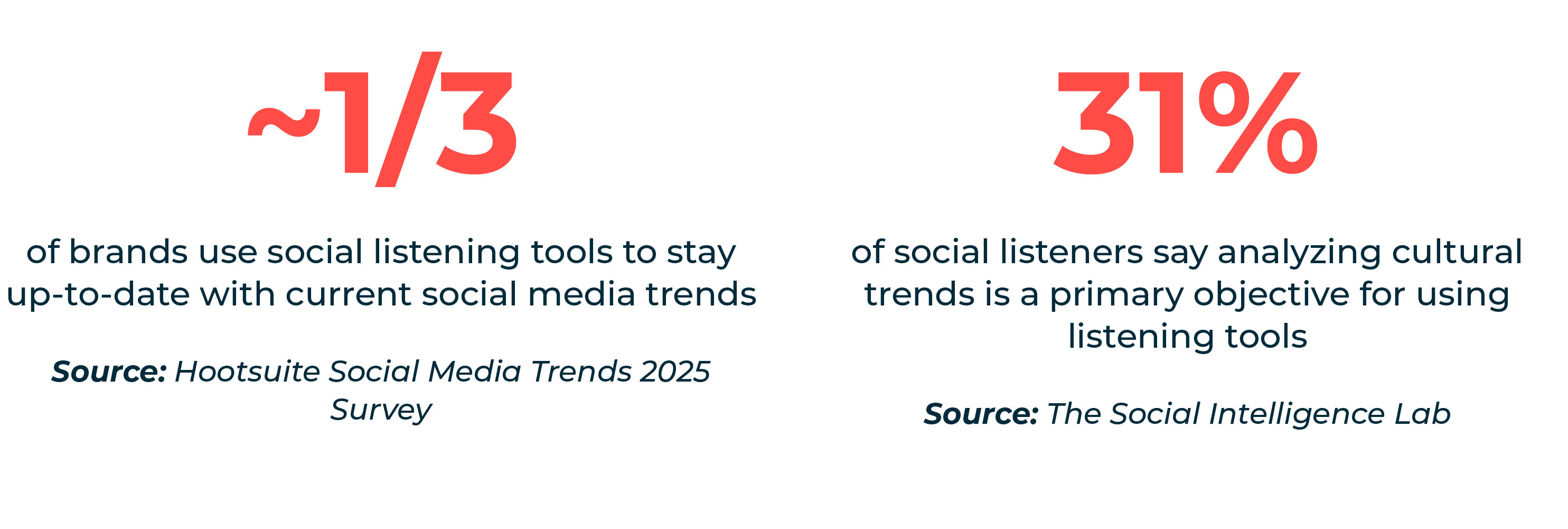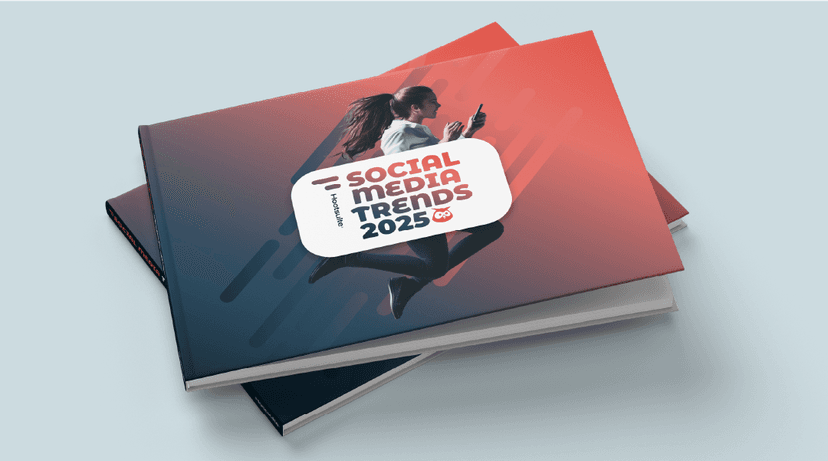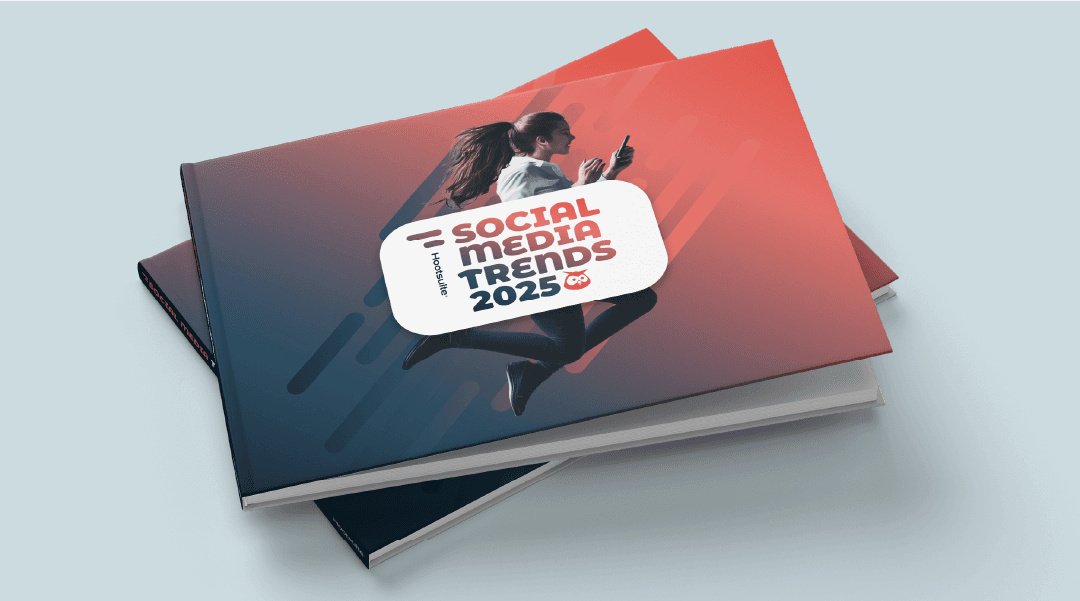Social Media Trends 2025
To win on social media, you gotta move fast. Dig in to see how the best in the biz are being agile, and how you can follow suit.

Our latest updates
May 2025
Now that we’re almost halfway through 2025, it’s the perfect time to do a pulse check on our social trends and see how they’re tracking. Check out our fresh insights to keep your social strategy sharp, relevant, and, most importantly, agile:
We’ve noticed that brands have been using Threads and X as spaces to experiment with tone, humor, and authenticity. Why? Many organizations just haven’t established clear guidelines for these platforms (yet), beyond simply aiming to entertain. So this is where they’re ditching polished messaging for unfiltered, real-time content that clicks with their audiences.
“Vibe” culture is on the rise, marking a shift from fleeting trends to slower, mood-driven moments. And marketers are evolving their trend-hopping strategies accordingly. They’re using social listening and AI to decode the mood and energy behind trends (not just sentiment) to help them curate longer-lasting emotional experiences that strengthen brand identity — not diminish it.
AI is the trend, but the real power move is sharing your prompts. Marketers have embraced AI so much that they’re now creating a culture of teaching and transparency. They’re no longer pretending they didn’t use AI to get that polished output and instead showing their peers how they got there. And while we’re on the subject of AI trends, the em dash continues to be a hot topic online — proof that even punctuation can go viral and get people fired up. (We’re team em dash — clearly.)
Can’t get enough social trends?
See a complete breakdown of what’s taking over in 2025. Read our blog
The top social media trends for 2025
1. Content Experimentation Trends:
The Creative Disruption Trend: Social teams ditch brand consistency to push creative boundaries
The Outbound Engagement Trend: Brands drop in on creators’ comments to pick up new audiences
2. Social Listening Trends:
The Social Performance Trend: Listening launches social pros into their performance marketing era
The Micro-Virality Trend: Social listening refines the art of trendjacking
3. AI Trends:
The AI Content Trend: Generative AI is off probation and officially on the team
The AI Strategy Trend: Social media strategists get a new thought partner

1. Content Experimentation Trends
The Creative Disruption Trend
Social teams ditch brand consistency to push creative boundaries
With new creative opportunities brought about by social platforms, we’re seeing more and more organizations loosen the reins, toss the traditional marketing playbooks aside, and prioritize entertainment on social media.

What’s interesting about this new creative precedent is its implications on brand consistency — or rather, inconsistency.
Adventurous teams are testing out such distinct voices and personas on social that their content barely resembles their brand personality on other marketing channels.
And these brands aren’t just getting away with it — they’re getting celebrated for it (and driving results). Social marketers who consistently post creative content are more likely to say they have a ‘very positive’ impact on the business than those who post creative content less frequently — a sign that their efforts are paying off.
After all, social media is the perfect playground for pushing creativity further, a place where even the most buttoned-up brands can have a little fun.
In 2025, more organizations will step outside their creative comfort zone and test content that pushes beyond their brand guidelines to capture and delight audiences.

Social Media Trends 2025 Webinar: Embracing Social Media Agility
In this on-demand webinar, hear from industry experts on how to use the latest trends and insights in content experimentation, social listening, and generative AI to build agility into your social strategy for 2025.
![]()
The Outbound Engagement Trend
Brands drop in on creators’ comments to pick up new audiences
These days, you can scroll down to the comments section of almost any social post and find a brand or two chiming in on the conversation.
These outbound engagements (brands commenting on other people’s posts) are picking up steam. But the smartest brands are strategically commenting on creator content, which helps them cultivate community while also putting their brand in front of new audiences.

Popping off in the comments may seem simple, but it needs to be approached as strategically as everything else you do on social media.
According to our partner, global social media agency Social Element, there are two critical factors that drive success for outbound engagements: timeliness and length.
Engagements decrease dramatically if you comment on an original post that’s more than 24 hours old. As for comment length, keep it short — but not too short. Comments between 10 and 99 characters drive the most engagement; anything more or anything less, including emoji-only comments, are a total bust.
But beware: Outbound engagements as a marketing and social selling strategy are gaining momentum, so creators might get choosy with their replies, avoiding brands that could compromise their authenticity and credibility.
In 2025, as more brands take a stab at proactive engagements, the most strategic ones will go beyond the comments section to foster genuine relationships with creators and their communities as a prerequisite to building successful outbound engagement strategies.

Turn your insights into action and drive real business impact now
![]()

2. Social Listening Trends
The Social Performance Trend
Listening launches social pros into their performance marketing era
Unlike performance marketing, which has a crystal clear connection to revenue, social media marketing has remained notoriously difficult to connect to ROI (a.k.a. the numbers that prove business success and win investment from leadership).
However, we’ve seen more social marketers reporting increased confidence in their ability to prove ROI — and it’s not from tracking “vanity metrics” such as likes, shares, and follows. This year, we saw that confidence reach its highest point among social pros who use one specific tactic: social listening.
Social listening lifts ROI confidence
Percentage of social listeners vs. non-listeners that feel confident in the ROI of each platform
Sample: 3,864 respondents
Source: Hootsuite Social Media Trends 2025 Survey
With its continuous stream of real-time insights, social listening helps organizations better understand their audience, improve their strategies, uncover market gaps to guide product development, spot potential crises so they can quickly take control, even drive sales — and prove it.
All of this gives social pros data that can be directly connected to ROI — something that used to exclusively belong in the performance marketing arena.

Listening has shown so much value that it’s now ranked by organizations as their second-highest priority on social media — outranked only by marketing to or engaging with their audience.
And because social pros are the social listening experts within their orgs, they’re finally coming to be seen as revenue powerhouses on the same playing field as other performance marketers.
In 2025, social teams that master social listening will earn more credibility and budget by delivering valuable insights, hard numbers, and even sales leads that drive growth and success across their organization.
The Micro-Virality Trend
Social listening refines the art of trendjacking
Remember when going viral was the be-all and end-all of social media success? These days, though, social marketers know better (for the most part). Chasing random and fleeting moments of virality is both ineffective and inauthentic — and nothing kills a trend faster than the inevitable dogpiling of brands. So it’s no shock that conversations around ‘going viral’ have become increasingly negative over the last year.
Attitudes towards ‘going viral’ have soured
Sentiment around viral marketing in 2024
Sample: 1,119,860 mentions
Source: Talkwalker
However there’s a big difference between ‘going viral’ and wisely tapping into the trends that make the internet go round. In fact, consumers like when brands get involved in cultural moments on social, according to our 2024 Social Media Consumer Report.
Social marketers who are chronically online (🙋♀️) have a nose for the hottest social media trends — a gift (curse?) that should be put to good use. But is it enough to simply know what’s trending?

Source: Hootsuite Social Media Trends 2025 Survey
Real-time data from social listening helps brands understand if a trend is resonating with their audience, what they’re saying, and how they feel about it — as well as if a trend has reached its peak, is tapering off, or still has some runway.

Now that more organizations are turning to social listening for otherwise hard-to-come-by insights, they can make more informed decisions about which trends to embrace and which to avoid. More than a quarter of social marketers already switch up their content because of cultural opportunities like memes and trends.
So when all the stars align, the most strategic brands are ready to pounce.
In 2025, brands will strive for smaller-scale, audience-focused virality to achieve goals more effectively. This means fewer organizations blindly piggybacking on mainstream social media trends, but more organizations tracking them for actionable insights.

Be agile like leaders in your industry
Orgs like yours are staying agile on social media with the help of Hootsuite. Don’t get left behind.
![]()

3. AI Trends
The AI Content Trend
Generative AI is off probation and officially on the team
When we released last year’s report, social marketers were just starting to experiment with ChatGPT and a limited number of other AI tools — if their organization let them. At the same time, they were concerned about what AI could mean for their future as social media managers.
Today, AI is considered a major asset. In fact, 69% of marketers now see AI as revolutionary technology that can create job opportunities. And social marketers are adopting countless generative AI tools to help with creativity and impact.
Most notably, use of generative AI for social media content creation has shot way up.
Social marketers double down on generative AI in 2024
Percentage of social marketers that used AI applications for the following social media activities
Sample: 3,843 respondents (2025), 2,865 respondents (2024)
Source: Hootsuite Social Media Trends 2025 Survey, Hootsuite Social Media Trends 2024 Survey
What’s fueled this growth? The insatiable social media machine and its constant need for content.
In-depth research conducted by Hootsuite and Critical Truth indicates that brands should aim to make between 48 and 72 posts per week across platforms. That’s A LOT of work.
And where better to turn for help than generative AI?

Source: Hubspot
From writing captions and translating scripts to creating images and drafting influencer proposals, AI is now everybody’s favorite assistant.
And get this: Our survey shows that organizations in heavily regulated industries like government, finance, and healthcare are now using AI more than loosely regulated industries, which is surprising given their strict compliance rules and privacy policies. But this really says it all — AI for content creation has become standard practice in social.
In 2025, using generative AI to create social content at scale will be table stakes as organizations continue to integrate AI extensively into their strategies and workflows — and those that don’t will get left in the dust.
The AI Strategy Trend
Social media strategists get a new thought partner
We’ve already established that generative AI has reshaped the way social pros create content. But did you know how much AI use has made its way up to higher-level strategic roles?
More than three-quarters of those responsible for social strategy (mainly C-level execs and VPs, according to our survey) report using AI to assist with social media activities.
And here’s the kicker: They’re already using it more than those responsible for execution.
Social media planners lean on AI the most
Percentage of social marketers that use AI for the following activities by role/responsibility
Sample: 3,864 respondents
Source: Hootsuite Social Media Trends 2025 Survey
We have the warp-speed adoption of AI features in strategy tools to thank for this. Now it’s easily accessible — if not expected — in analytics, campaign management, brand forecasting, and so much more. It can even provide executive summaries so you don’t have to attend a billion meetings (but you probably should).
This shows that beyond efficiency, AI has become the thought partner social marketers never knew they needed (almost half of marketing leaders have invested in AI tools for their team, new Hubspot research shows).
So it got us wondering: What do the organizations and social teams moving the fastest to bring AI on board — as a tool not just for content creation, but for strategic thinking — have in common?
It turns out that among our survey respondents, these teams are also the ones who update their strategy most frequently.
Of course, there are a lot of reasons why an organization might make frequent updates to their strategy. Whatever the reason, one thing’s for sure: Organizations that prioritize agility in their strategies also prioritize AI use across their social teams.
In 2025, social teams that invest in building out their strategic AI capabilities alongside their tactical ones will drive efficiency and insights that enhance marketing effectiveness and open the door to new opportunities.

Time to enter your social performance era
![]()

Wait, there’s more!
Get even more juicy stats, guidance, and insights from industry insiders in the full report.
The industry trends we know you want

Education Trends
Get your A+ on social strategy with hot new insights.

Government Trends
The social media rulebook keeps changing — don’t get caught red handed.

Financial Services Trends
*cue singing* You’re looking for some trends in finance — trusted, bite-sized, well-timed.

Healthcare Trends
Build social media agility to keep your social strategy fit in 2025.

Nonprofit Trends
All you need to make an impact on social and beyond.

Build an agile social strategy for 2025
More detailed how-to’s, tips from social media insiders, a peek at the best social pros’ tactics, and more — all in one neat package.
